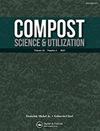Feedstock Carbon Influence on Compost Biochemical Stability and Maturity
IF 0.9
4区 农林科学
Q3 ECOLOGY
引用次数: 6
Abstract
ABSTRACT Quantity and quality of readily degradable carbon influences the composting process especially for compost mixture high in lignocellulotic material. Effects of carbon source on stability and maturity of compost from in-vessel systems are poorly understood. Research was conducted to investigate the effects of carbon composition of feedstock on the evolution of stability indices and reliability of maturity tests for accelerated vessel composting systems. Rice straw, sugarcane bagasse, and coffee hulls were composted in a modified rotary in-vessel composter amended with either cattle or sheep manure. Distinct evolution patterns were observed across carbon sources for temperature, with the sugarcane compost never attaining thermophilic temperatures. Time to peak temperature and return to ambient were significantly different between the rice and coffee compost. Comparatively, organic matter degradation followed a similar pattern for all carbon sources, although rice straw showed the faster degradative rate and coffee hulls the greatest overall loss. Both pH and electrical conductivity were inappropriate stability indices across carbon sources, while the NH4+/NO3− ratio was lower than the threshold from week 1. The Solvita® maturity test was the best suited quality indicator and was related to compost respiration. The rice compost at week 12 was the only mature compost with an index value of 7. However, the coffee compost was in the curing stage with a value of 6. In vitro phytotoxicity assays on hot pepper contrasted the Sovita® interpretation for rice compost, which showed the lowest germination index. All compost had a stimulatory effect on cucumber seeds. In vivo seeding assays corroborated in vitro results with rice compost showing the greatest negative effect, augmented at 100% compost inclusion. Carbon source significantly influenced compost stability and maturity indices, which suggests that greater attention should be directed to quality indices in relation to feedstock composition.原料碳对堆肥生化稳定性和成熟度的影响
易降解碳的数量和质量影响着堆肥过程,特别是对于木质纤维素材料含量高的堆肥混合物。碳源对容器系统堆肥稳定性和成熟度的影响尚不清楚。研究了原料碳组成对加速容器堆肥系统稳定性指标演化和成熟度试验可靠性的影响。稻秆、甘蔗渣和咖啡壳在改良的旋转式容器堆肥机中进行堆肥,并用牛粪或羊粪进行改性。不同的碳源在温度上观察到不同的进化模式,甘蔗堆肥从未达到嗜热温度。稻谷和咖啡堆肥达到峰值温度和返回环境的时间有显著差异。相比之下,所有碳源的有机物降解都遵循类似的模式,尽管稻草的降解速度更快,咖啡壳的总体损失最大。pH和电导率都是不合适的碳源稳定性指标,NH4+/NO3−比值低于第1周的阈值。Solvita®成熟度测试是最合适的质量指标,与堆肥呼吸有关。第12周的水稻堆肥是唯一成熟的堆肥,指数为7。而咖啡堆肥处于固化阶段,值为6。在辣椒的体外植物毒性试验中,对比了水稻堆肥的Sovita®解释,结果表明萌发指数最低。所有堆肥对黄瓜种子均有刺激作用。体内播种试验证实了体外结果,水稻堆肥显示出最大的负面影响,在100%堆肥中增加。碳源对堆肥稳定性和成熟度指标有显著影响,应重视与原料组成相关的质量指标。
本文章由计算机程序翻译,如有差异,请以英文原文为准。
求助全文
约1分钟内获得全文
求助全文
来源期刊

Compost Science & Utilization
农林科学-生态学
CiteScore
4.10
自引率
0.00%
发文量
0
审稿时长
>36 weeks
期刊介绍:
4 issues per year
Compost Science & Utilization is currently abstracted/indexed in: CABI Agriculture & Environment Abstracts, CSA Biotechnology and Environmental Engineering Abstracts, EBSCOhost Abstracts, Elsevier Compendex and GEOBASE Abstracts, PubMed, ProQuest Science Abstracts, and Thomson Reuters Biological Abstracts and Science Citation Index
 求助内容:
求助内容: 应助结果提醒方式:
应助结果提醒方式:


